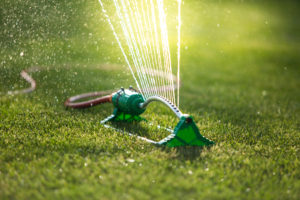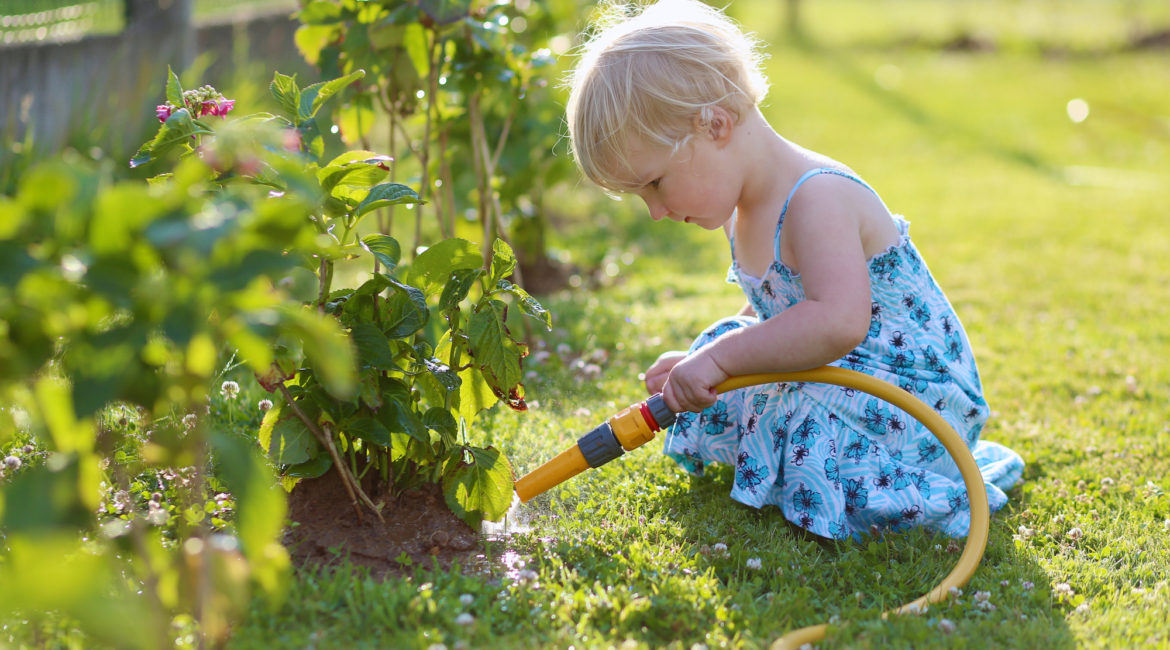During the hot summer months, Mother Nature can be pretty inconsistent in our region. Dreary, rain-soaked days are followed by hot, dry weeks. While we’re not thrilled with those rainy days for summer fun, our flower and vegetable gardens love them. In fact, without those great, deep soaks, our flowers and veggies are pretty pitiful! During those hot, dry weeks, it is important to monitor your plants for signs of stress from a lack of water. Every plant is different, and may require differing amounts of water. Annuals generally require more frequent water than perennials due to the fact that they have more shallow roots. Deeper roots can tap into moist soil well below the surface and therefore will be able to withstand a drought better than shallow ones. Below are more tips on summer watering to help keep your flower and vegetable gardens producing their best.
Water the roots, not the foliage. The roots of your plants, not the leaves, are responsible for water intake. Watering the leaves or flowers is therefore a waste of water. Not only that, water that sits on leaves during hot sunny days can magnify the sun and burn your foliage. Think of it like a dry leaf under a magnifying glass. Instead, focus on getting water directly to the soil surrounding your plants.
Avoid over or under watering. Over watering can result in rotting roots, and yellow leaves. Under watering causes plants and flowers to wilt, and vegetables to cease producing. Both can kill your plants. When plants show signs of either, water (or not) accordingly.
Water deeply. Annual plants and perennial plants require different depths of watering. Vegetables and flowers planted in the same season will have shallow roots, and will not require as much water to reach to the root. Perennial roots can be further down and will require more watering to reach them. Although perennial roots require a deeper soak, you shouldn’t need to water them as often as annuals since their roots tap deep into more moist soil below.
Morning and evening are the best times to water. From late morning to early evening, your plants are busy soaking up the hot summer sun, and the soil is busy losing water rapidly. Therefore, during the early morning or late evening, water will evaporate from the soil at a slower rate. This will give your plants a chance to soak it in and stay perky during peak sun hours.
 The best way to water is through drip irrigation or a soaker hose. If possible, using the method of soaking the soil directly as opposed to spraying or sprinkling is more effective. About 40% of the water you use from a spray hose or sprinkler will instantly evaporate into the air. However, to water large areas, it may be your only option. If it is, just know to accommodate for the water loss, and water for a longer period of time.
The best way to water is through drip irrigation or a soaker hose. If possible, using the method of soaking the soil directly as opposed to spraying or sprinkling is more effective. About 40% of the water you use from a spray hose or sprinkler will instantly evaporate into the air. However, to water large areas, it may be your only option. If it is, just know to accommodate for the water loss, and water for a longer period of time.
Cover up! Use mulch or straw to help keep water from evaporating too quickly. Covering the soil in your flower beds with mulch, and your vegetable garden with straw will help keep water from evaporating as quickly as it would with bare soil. Several inches of covering is best.
What to do with potted plants? When watering potted plants, always be sure that your planter has a drainage system in the bottom. Holes in the main pot, with a water receptacle underneath is best, as the bottom receptacle acts as a secondary source of water to be absorbed when the plant becomes dry again. Check to see if potted plants need watering by either observing for stress, or feeling the surface soil. For hanging baskets, take note of the weight of the basket when soaked and when dry. To check for the need to water, simply lift gently on the basket. If it is too light, it’s time to water!
We hope these helpful watering tips have helped! If you need additional assistance with your landscape needs, contact the landscape professionals at Chesapeake Landscape Group.

